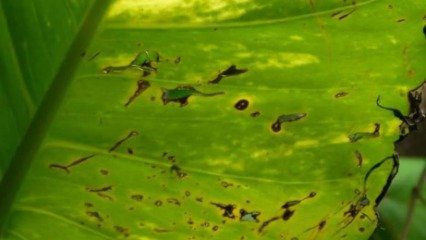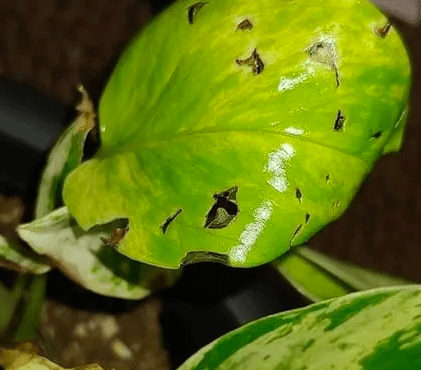
Holes In Pothos Leaves – The Main Reasons and Solutions
Pothos plants are one of the best plants to have in your home because they thrive on neglect. You can forget about watering them, and they will still grow strong. Unfortunately, there is a downside to this plant: sometimes it gets holes in its leaves!
This blog post will list the main reasons why pothos leaves get holes, as well as some solutions that you can use to fix it.
Why Are There Holes In My Pothos Leaves?
Holes in your pothos leaves are generally because of liriomyza melanogaster infestation. This is a pest that tunnels into your beloved pothos plant, which causes small holes to appear.
These pests love to chew on pothos leaves, and they will quickly move from one leaf to the next if left unchecked. The good news is that there are a few things that you can do to get rid of them!
This can be a surprise for many, as the pest hides during the day. They do most of their “mining” during the hours of darkness, so you may not even know that they are there until the damage is already done.
But that’s not all… Pothos plants are also susceptible to a fungal disease that gives holes that causes holes and discolored leaves. You can usually tell if your plant has a fungal disease because the leaves will usually look slimy and wet.
How To Stop Holes in Pothos Leaves?
The only way to stop pests from attacking your pothos is to remove the pests from the plant with a pesticide, like a neem oil or pyrethrum. Be sure to read the instructions on the pesticide thoroughly so that you know how to use it safely and effectively.
Your plants will have to be treated on a regular basis. Giving a dose of neem oil spray (Amazon link) will remove any pests from your pothos. You may want to sprinkle the neem oil on all of your plants, just in case the pests make a run for it!
Simply mix the neem oil with water according to the directions on the bottle. Then, use a spray bottle to apply the mixture to your plants, making sure to coat the underside of the leaves where pests like to hide.
If your pothos has a fungal disease, then you will need to take steps to remove the fungus from the plant. This can be done by spraying the affected leaves with neem oil or a similar fungicide.
You can also remove the affected leaves from your plant by cutting them off near their base to remove any fungal spores that may still be attached to them. Make sure to discard them away from your home to avoid reinfecting the plant!
Once you have treated your plant, you will need to keep an eye on it to make sure that the holes don’t come back. If they do, then you will need to re-treat the plant with pesticides or fungicides.

How to Keep Pests Away From Pothos Leaves?
The best way to keep pests away from pothos leaves is to practise good plant care. This means giving the correct amount of water, fertilizer, and light that your plant needs to stay healthy. A healthy plant is better able to fight off pests and diseases than a weak one.
You can also try using yellow sticky traps to catch any flying pests before they have a chance to land on your plants. These traps are coated with a sticky substance that will trap the pests, preventing them from doing any damage.
You can also remove any potential hiding places for them. This means that you should trim back any overgrown leaves and branches, as well as remove any dead leaves from the plant.
What Else Causes Holes in Pothos Leaves?
We have already discussed the two main reasons for holes in rhododendron leaves, but there are a few other things that can cause them:
Animals
If your pothos is outside, then it is possible that an animal has been nibbling on the leaves. This could be anything from a rabbit to a deer, so you will need to take steps to protect your plant if this is the case.
The best way to do this is to put a fence around your plant or to cover it with netting. This will stop the animals from being able to reach the leaves and will protect your plant.
You may even have a pet that is causing the holes in your rhododendron leaves! If you think that this is the case, then you will need to take steps to stop them from being able to reach the plant.
Weather
Hail and strong winds can cause holes in pothos leaves, as well as other types of damage. If you live in an area that is prone to bad weather, then you should take steps to protect your plants.
The best way to do this is to put them in a sheltered spot, such as next to a wall or under a tree. This will stop the wind from being able to reach them and will protect them from any hail or other debris that might be blown around.
Physical Damage
Holes in pothos leaves can also be caused by physical damage. This could be anything from being hit by a ball to being scratched by a cat.
If your plant is new, maybe the distributor or store didn’t wrap it properly and it got damaged in transit.
If you think that physical damage is the cause of the holes in your pothos leaves, then you will need to take steps to protect the plant. This means that you should keep it in a safe place where it won’t be hit or scratched.
Should I Prune Pothos Leaves with Holes?
There’s usually no need to prune pothos leaves with holes, as the plant will eventually outgrow them. However, if the holes are caused by a pest or disease, then you may need to remove the affected leaves.
This will prevent the pests or diseases from spreading to other parts of the plant and will also stop them from doing any further damage.
Pruning is also a good way to encourage new growth, so if your plant is looking a bit sparse, then pruning the affected leaves can help to promote new growth.
What are Leaf-Mining Pothos Pests?
A leaf-mining pest is a type of insect that burrows into the leaves and eats away at them. This can eventually leave your pothos plant without even one green leaf left on it! Luckily, there are ways to treat this problem so you don’t have to worry about it happening in the future.
Other pothos pests include aphids, mealybugs, and scale. The first step in treating your plant is to identify the pest that’s attacking it. Once you’ve done this, pick up some neem oil to get rid of them as soon as possible!
How To Keep Your Pothos Healthy?
Soil: Pothos like moist soil that isn’t too wet. The pH range of the soil should ideally be around 6 to 6.5.
Location: Place your pothos near the indirect light that is received daily. The plant should be kept away from cold drafts.
Watering: Pothos plants thrive when they’re regularly watered, but ensure you don’t water until the soil is dry at the top. Being mindful of your watering schedule is one way to avoid over-watering.
Fertilizing: To maintain the growth of your pothos plant, give it some liquid fertilizer every 4 weeks or so.
Temperature and humidity: If possible, you should keep your indoor or outdoor pothos plant at a temperature between 60-80°F. A humidifier can help your plant thrive in any home environment.
Pruning: To stop leggy foliage, you should occasionally prune it.
Conclusion
Leaf-mining pests are the main problem when it comes to pothos leaf holes. There’s also the chance of fungal infection. Either way, you should be able to stop the holes by using some neem oil spray (Amazon link).
Remember to keep an eye on the overall health of your pothos plant. This includes making sure it’s receiving the right amount of water, fertilizer, and light. A healthy plant is more likely to resist pests and diseases!
Do you have any other tips for keeping pothos plants healthy? Let us know in the comments below!
